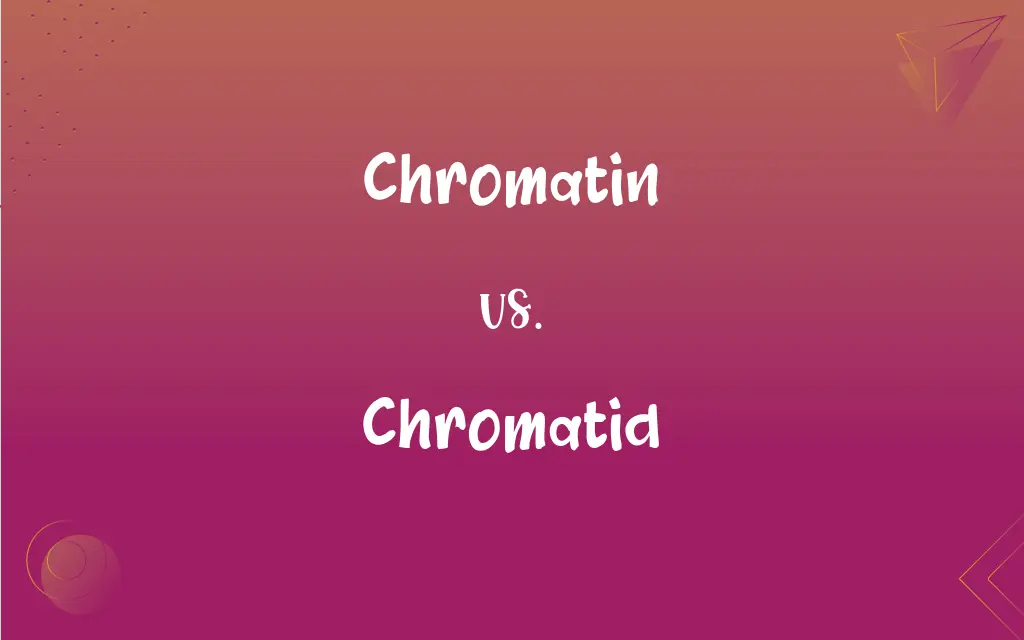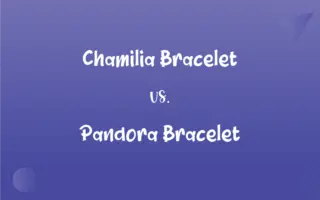Chromatin vs. Chromatid: What's the Difference?
Edited by Janet White || By Harlon Moss || Updated on October 6, 2023
Chromatin is the material comprising DNA and proteins in a nucleus; a chromatid is one of two identical halves of a duplicated chromosome.

Key Differences
Chromatin and chromatid are both related to chromosomes but differ in structure and function. Chromatin is the complex of DNA and proteins that makes up chromosomes. It plays a crucial role in the packaging of DNA within the cell nucleus, ensuring that the long DNA molecules are compacted and fit within the confines of the nucleus. On the other hand, a chromatid is a term that represents one of the two identical halves of a duplicated chromosome, which are joined together by a centromere.
Chromatin's composition includes histone proteins, around which DNA winds, forming a structure called nucleosomes. This structure allows for the DNA to be efficiently packed and also plays a role in gene regulation. Chromatid, in its essence, is a copy of the chromosome and is crucial for ensuring that during cell division, each daughter cell gets an identical set of genetic material.
During the cell cycle, chromatin undergoes various changes to facilitate processes like DNA replication and transcription. Chromatin's flexibility ensures that the DNA is accessible for replication and transcription. Chromatids, however, become most evident during cell division, particularly in the mitotic phase when the chromosome duplicates, resulting in two chromatids.
In summary, while chromatin and chromatid are intimately related in the context of chromosomes, they serve different purposes. Chromatin provides a mechanism to package and regulate DNA within the nucleus, and chromatids are pivotal for accurate genetic material distribution during cell division.
Comparison Chart
Composition
DNA and proteins (especially histones)
One of two identical halves of a duplicated chromosome
ADVERTISEMENT
Function
Packaging and regulating DNA
Ensures accurate genetic distribution during cell division
Visibility
Present throughout the cell cycle
Most evident during cell division
Structural Unit
Nucleosomes
Joined with its sister by a centromere
Role in Cell Division
Undergoes changes to facilitate DNA replication
Represents duplicated DNA to be divided between cells
Chromatin and Chromatid Definitions
Chromatin
Complex of DNA and proteins in chromosomes.
Under the microscope, the nucleus showed dense regions of chromatin.
ADVERTISEMENT
Chromatid
One half of a duplicated chromosome.
After DNA replication, each chromosome consists of two identical chromatids.
Chromatin
Material responsible for DNA packaging in the nucleus.
The chromatin structure changes during gene transcription.
Chromatid
Joined to its sister chromatid at the centromere.
The centromere holds the chromatids together until they're ready to separate.
Chromatin
DNA wound around histone proteins.
The presence of chromatin ensures the DNA is compacted within the nucleus.
Chromatid
Visible during specific phases of the cell cycle.
Chromatids become distinct during the late stages of cell division.
Chromatin
Plays a role in regulating gene expression.
Alterations in chromatin can influence gene activity.
Chromatid
Represents an identical copy of DNA for division.
The chromatids separate during anaphase of mitosis.
Chromatin
Structure facilitating DNA compaction and protection.
The organization of chromatin is vital for DNA's integrity and function.
Chromatid
Ensures accurate genetic distribution during cell division.
Each daughter cell receives one chromatid from every chromosome pair.
Chromatin
A complex of nucleic acids and proteins, primarily histones, in the cell nucleus that stains readily with basic dyes and condenses to form chromosomes during cell division.
Chromatid
One of two identical strands into which a chromosome splits during mitosis.
Chromatin
(biology) A complex of DNA, RNA and proteins within the cell nucleus out of which chromosomes condense during cell division.
Chromatid
Either of the two daughter strands of a replicated chromosome that are joined by a single centromere and separate during cell division to become individual chromosomes.
Chromatin
Tissue which is capable of being stained by dyes.
Chromatid
(genetics) After DNA replication, either of the two connected double-helix strands of a metaphase chromosome that separate during mitosis.
Chromatid
One of two identical strands into which a chromosome splits during mitosis
FAQs
Can chromosomes exist without chromatin?
No, chromosomes are made up of chromatin.
How many chromatids does a duplicated chromosome have?
A duplicated chromosome has two chromatids.
Do chromatids exist in non-dividing cells?
No, chromatids are specific to cells that have duplicated their DNA, preparing for division.
Are chromatids always identical?
Sister chromatids, resulting from DNA replication, are identical copies of each other.
Why is chromatin important for the cell?
Chromatin packages DNA efficiently in the nucleus and plays a role in DNA protection and gene regulation.
When do chromatids separate?
Chromatids separate during anaphase in both mitosis and meiosis.
Can chromatin be visualized under a microscope?
Yes, dense regions of chromatin can be seen under a microscope.
How does chromatin's structure affect gene accessibility?
Chromatin's structure can either expose or hide DNA sequences, influencing their accessibility to the transcription machinery.
What happens to the chromatid after cell division?
Each chromatid becomes a chromosome in the daughter cells.
Is chromatin always in the same state?
No, chromatin can exist in a more relaxed (euchromatin) or condensed (heterochromatin) state.
Does chromatin play a role in DNA replication?
Yes, the chromatin structure facilitates DNA unwinding for replication.
What ensures chromatids separate accurately during cell division?
The mitotic spindle and associated proteins ensure accurate chromatid separation.
What are the functional units of chromatin?
Nucleosomes, consisting of DNA wound around histones, are the functional units of chromatin.
How do chromatids contribute to genetic diversity?
In meiosis, chromatids can undergo genetic recombination, contributing to genetic diversity in offspring.
What proteins are primarily associated with chromatin?
Histone proteins are the primary proteins associated with chromatin.
Are chromatids found in all cells?
Chromatids are evident in cells that have undergone or are undergoing DNA replication, particularly before cell division.
Can chromatin be modified?
Yes, chromatin modifications like methylation and acetylation can affect gene expression.
What is the primary difference between chromatin and chromatid?
Chromatin is DNA-protein material in the nucleus; a chromatid is half of a duplicated chromosome.
What role does chromatin play in gene regulation?
Chromatin structure can facilitate or hinder gene transcription, affecting gene expression.
Are all chromatids attached by a centromere?
Yes, sister chromatids are connected at the centromere.
About Author
Written by
Harlon MossHarlon is a seasoned quality moderator and accomplished content writer for Difference Wiki. An alumnus of the prestigious University of California, he earned his degree in Computer Science. Leveraging his academic background, Harlon brings a meticulous and informed perspective to his work, ensuring content accuracy and excellence.
Edited by
Janet WhiteJanet White has been an esteemed writer and blogger for Difference Wiki. Holding a Master's degree in Science and Medical Journalism from the prestigious Boston University, she has consistently demonstrated her expertise and passion for her field. When she's not immersed in her work, Janet relishes her time exercising, delving into a good book, and cherishing moments with friends and family.































































